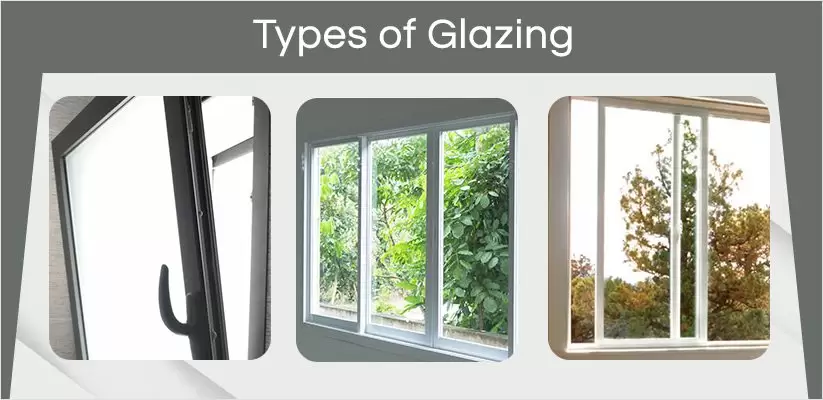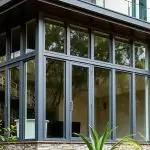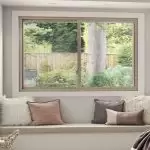Windows prove to be one of the integral elements of any house, office, or any other building, serving as the eyes of the people to the outside world without actually needing to go outside. These are the structures that ensure proper ventilation and the flow of natural light indoors while maintaining the privacy and security of the indoors. The different types of window designs have incredibly evolved with the advancements in technology as well as the industry. One of the innovative ideas is to go for energy-efficient windows with the diverse glazing options in the industry. Glazed windows are the newest structures that serve the high-performance window designs that reduce heat transfer with reduced air leakage concerns and help to maintain a comfortable and quiet environment indoors.
Post your Requirement
What is Window Glazing?
The term glazing is derived from the word ‘glass’ and typically refers to a wall or a window that is constructed with glass. Window glazing refers to the process of where glass within a window frame to elevate both the aesthetic appeal and the functional efficiency of the structure. The process typically refers to the process of securing and sealing the glass within the window frame using materials such as putty, gaskets, or sealants and incorporating features such as superior energy efficiency, reduced outside noise, and enhanced safety for the occupants.
What Are The Advantages of Window Glazing?
Glazing is an innovative process that helps to insulate the interiors with reduced energy consumption and the maintenance of a comfortable and constant temperature indoors. There is a wide range of advantages to the window glazing options. Some of them are as follows:
- Energy Efficiency: The most basic role and feature of the window glazing is to ensure a considerable level of energy efficiency in the spaces. The glazed windows, with their thermal insulation properties, allow people to keep their interiors cooler in summer and warmer in winter, reducing energy needs.
- Lower Energy Consumption: With their excellent insulation properties, the glazed windows help to reduce the reliance on heating and cooling systems for the maintenance of a cozy temperature indoors. This reduced energy consumption needs help the people to cut their electricity bills and overall expenses.
- Safety and Security: There are numerous glazing options such as the reinforced or laminate glass that are built for enhanced security needs. They prove to be harder to break structures thereby ensuring effective protection against break-ins. The different glazing options also ensure a reduced risk of accidents in natural disasters or harsh weather.
- Sound Insulation: If you go for the superior types of glazing options, such as double or triple glazed, or the specialized glazing options, such as laminated glass or others, they come with an impressive standard of sound insulation as well. The sound insulation allows you to maintain a quiet and calm environment indoors, even with loud noises outside, particularly effective in buildings located near airports or busy roads in a city.
- Lesser Interior Fading: The decor items and the furniture surface tend to fade with prolonged exposure to heat or sunlight. The window glazing helps to reduce the excess heat and also protects the structures from damage from UV rays, thereby ensuring the long-term durability and performance of the furniture elements.
- Visual Appeal: Glazing can greatly elevate the appearance and appeal of diverse buildings. Whether you wish to create a sleek modern design or a traditional style, window glazing are versatile structures that create stunning views and a sense of openness in a variety of designs.
What Are the Different Types of Window Glazing?
There is a wide variety of types of window glazing in the industry that are ideal for different functional and aesthetic purposes. Some of the common types of window glazing solutions include the following:
1. Single Glass Glazing
As the name suggests, this is a type of glazing option that comprise of a single layer of glass. This is a simple and affordable choice that reduce the heat transfer and the flow of natural light but is comparatively less effective than the other options. This type of glazing is mainly found in older buildings or low-cost construction with low energy efficiency needs.
Benefits Of Single Glass Glazing
- Affordable: Cheapest option for basic glazing.
- Lightweight: Easy to install and replace.
- Good for Mild Climates: Suitable for areas with minimal temperature fluctuations.
- Maximum Light Transmission: Allows natural light to pass through without obstruction.
2. Double Glass Glazing
Double glazing refers to a kind of glazing option that comprises two layers of glass with an air gap in between. This is a superior option compared to single glazing and ensures better thermal performance and noise reduction. This is a type of glazing solution ideal for residential homes in climates with extreme temperatures due to its ability to maintain a comfortable temperature indoors with reduced heat transfer. They also provide a good level of soundproofing capabilities as well.
Benefits Of Double Glass Glazing
- Better Insulation: Reduces heat loss, improving energy efficiency.
- Noise Reduction: Minimizes outside noise, ideal for urban areas.
- Condensation Control: Reduces moisture buildup on glass surfaces.
- Increased Security: Harder to break compared to single glazing.
3. Triple Glass Glazing
Triple glass glazing refers to a kind of arrangement that comprises three layers of glass with two air gaps in between. The presence of additional panels ensures superior noise reduction and works better at insulation as compared to the single pane glass options. These are particularly ideal structures for French windows or large-sized window designs with enhanced security and insulation properties.
Benefits Of Triple Glass Glazing
- Superior Thermal Insulation: Minimizes heat transfer, ideal for extreme climates.
- Enhanced Noise Reduction: Provides better soundproofing than double glazing.
- Higher Energy Efficiency: Reduces heating and cooling costs.
- Improved Comfort: Maintains stable indoor temperatures year-round.
Additional Glass Options for Quality Glazing
Tempered or Toughened Glass
Tempered or toughened glass refers to a type of glass that is typically produced with an innovative chemical process to ensure superior strength and robustness. This type of glass is heated and then rapidly cooled to ensure unmatched strength and security of the interiors. This is a type of glass that, when it breaks, falls into smaller granular pieces rather than uneven glass pieces with sharp edges. It is particularly used in large window designs for commercial or industrial applications, vehicle windows, aquariums, cookware, bathroom shower doors, and other similar applications.
Benefits of Tempered or toughened Glass
- High Strength: 4-5 times stronger than regular glass.
- Shatter Resistance: Breaks into small, harmless pieces, reducing injury risks.
- Heat and Impact Resistant: It can withstand high temperatures and physical stress.
- Ideal for Safety Applications: Used in doors, windows, and high-rise buildings.
Laminated Glass
Laminated glass refers to a kind of stylish and high-strength glass that is made by sandwiching a layer of plastic between two layers of glass, thereby forming a permanent bond. The interlayers in this type of process are created under high heat and pressure, thereby imparting incredible strength and sturdiness to the material. When the laminated glass breaks, the interlayer of the material holds the glass intact and prevents the glass from shattering into pieces. This type of glass is particularly used for stylish windows in jewellery stores, skylight glazing, and other structures where security is a considerable concern.
Benefits of Laminated Glass
- Shatter-Proof: Holds together when broken, preventing injury.
- Improved Security: Harder to break through, offering better protection.
- UV Protection: Designed to block harmful UV rays, preventing damage to interiors.
- Better Soundproofing: Reduces outside noise, ideal for offices and homes.
Annealed Glass Or Float Glass
The float glass or the annealed glass refers to a kind of glass sheet that is manufactured with the floating molten glass by the process of cooling molten glass slowly to reduce internal stress. This type of glass is made with raw materials such as limestone, sand, dolomite, soda, and salt cake, which are typically melted in a furnace before they are poured into a chamber of a bed of molten metal like tin. This type of glass is used for modern window and door designs along with automobile glass and mirrors due to its safety and soundproofing features.
Benefits of Annealed Glass Or Float Glass
- Basic and Economical: The most commonly used standard glass.
- Easily Processed: Can be cut, drilled, or shaped for various applications.
- Smooth and Clear: The Surface provides good visibility and clarity.
- Suitable for Further Processing: It can be toughened or laminated for enhanced strength.
Clear or Tinted glass
As the name suggests, this is the category of glass where you can choose based on your aesthetic needs. You can either get a clear glass that is transparent with no tints or coatings or get the tinted glass options for a translucent film that helps to reduce the flow of natural light indoors and, thus, a good standard of energy efficiency indoors. The tinted glass refers to be a superior choice for both visual appeal and protection against UV rays, thereby making the structure perfect for high-rise buildings and office spaces.
Benefits of Clear or Tinted Glass
- Aesthetic Variety: Tinted options enhance building aesthetics.
- Glare Reduction: Tinted versions reduce glare from the sun.
- Improved Privacy: Darker tints can enhance privacy while still allowing visibility.
- Solar Heat Control: Helps in reducing heat gain, making interiors more comfortable.
Low-emissivity (Low-E) Glass
This is the most advanced choice for glazing solutions that come with premium features that last a lifetime. The low-emissivity (Low-E) glass refers to a type of glass that has a coating done on one or more surfaces with metallic oxide to reflect infrared light and UV rays. This feature allows the structures to reduce the loss of heat in windows and the flow of heat indoors in summer. This type of glazing ensures superior protection from UV rays and is highly effective in maintaining energy efficiency with reduced electricity costs.
Benefits of Low-emissivity (Low-E) Glass
- Energy Efficient: Reduces heat transfer, lowering heating and cooling costs.
- UV Protection: Blocks harmful rays, preventing interior fading.
- Maintains Indoor Temperature: Keeps interiors warmer in winter and cooler in summer.
- Eco-Friendly: Reduces carbon footprint by improving insulation efficiency.
Get The Right Glazing Option For Your Specific Functional And Visual Needs
Whether you are getting high-quality window designs for your home or office spaces, getting the best glazing option is crucial to ensure a perfect balance of energy efficiency, safety, and calmness in interiors. With a wide range of glazing options available in the industry, you can carefully consider your specific functional and aesthetic needs along with your budget constraints while choosing the right glazing option for you. You should even consult the established window manufacturers in the region to get the highest-quality products with premium features for your spaces.























Post A Comment